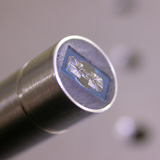| about | products | solutions | publications | contact | |
|
LDV/LDA microS microV miniPCS |
|
how a microV™ works |
 |
A holographic optic is a lens with features on it that are smaller than the wavelength of light. When light enters a medium such as glass or water, its speed is decreased. The "index of refraction" of a medium is a relative measurement of the speed of light as compared to that in a vacuum—the higher the index, the lower the speed of light. This means that small pieces of glass can be used to "slow down" part of the wave so that, when it emerges it can interfere with other parts of itself. The result is an amazing capability to "shape" laser beams. Measurement of Speed and Direction with No Moving PartsIn the microV, the proprietary holographic optic generates two microscopically thin laser sheets a specific distance from the sensor face (see figure). The optic also incorporates two distinct receivers—one for each laser sheet. This allows the distinction of which laser sheet was crossed first, which gives, of course, the direction of flow. The region of observation of the microV is so small that it is practically impossible for the time of flight measurement to be "confused"—that is, it is virtually impossible for a particle to cross the first laser sheet just before a second, distinct particle crosses the second sheet. Like the microS, the rugged, no-moving-parts design is a benefit when looking for a permanent instrumentation solution or for rugged environments. A great example of this is its use as part of an instrumentation package for an unmanned underwater vehicle. 1 | 2 |